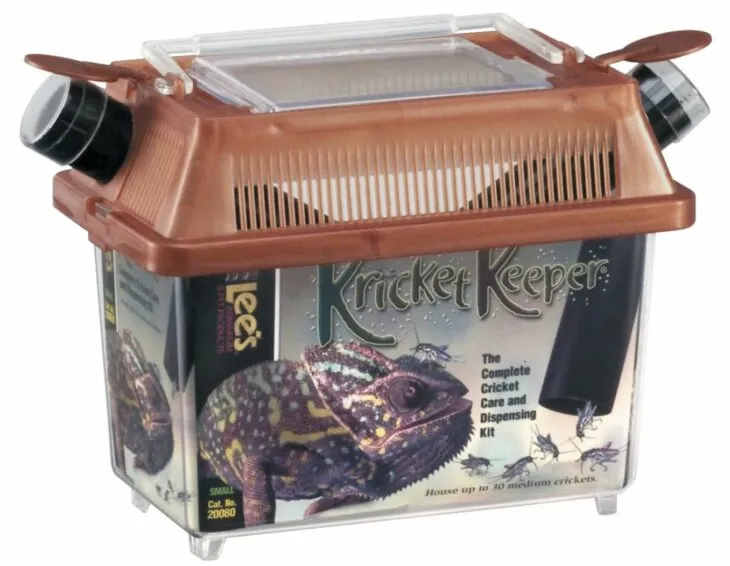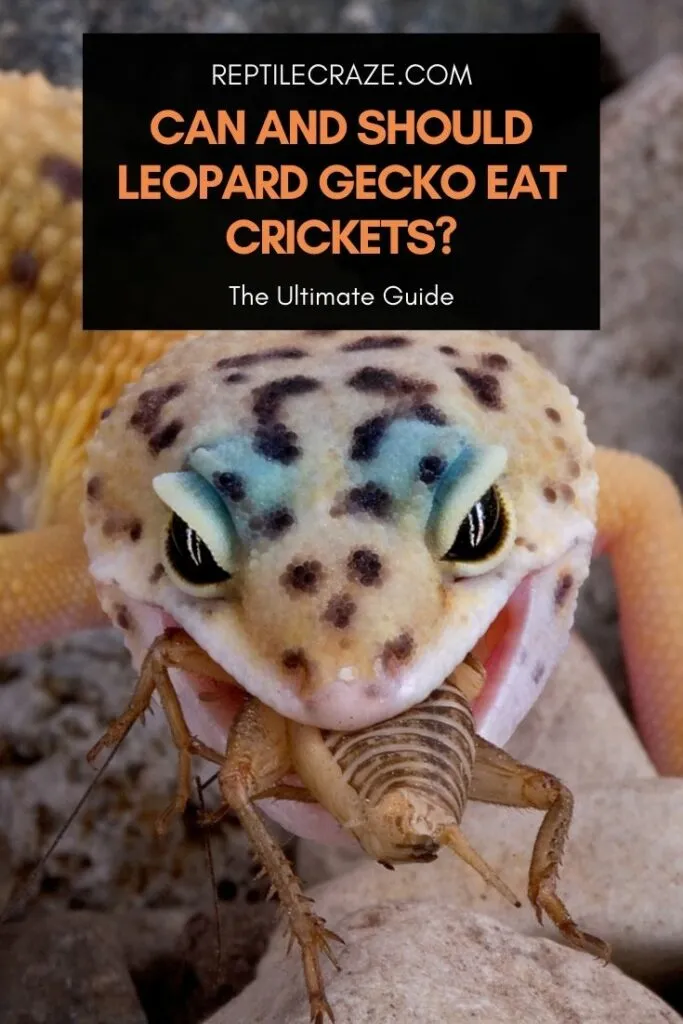
Crickets (Acheta domesticus) are an extremely popular feeder insect for Leopard Geckos (Eublepharis macularius). But, are crickets really that good for your Leopard Gecko? In this article, we will explore whether your Leopard Gecko can and should eat crickets.
Crickets are a good staple feeder for Leopard Geckos, as they are high in protein and very low in fat. However, they should be fed as part of a varied diet and must be gut loaded and dusted properly to balance the calcium to phosphorus ratio.
That’s the quick answer, but there is much more to learn. Read on to find out why your Leopard Gecko also needs an occasional fatty treat and how to troubleshoot when your Leopard Gecko won’t eat crickets.
Table of Contents
Leopard Geckos Can And Should Eat Crickets
Crickets are not harmful to Leopard Geckos if prepared and fed correctly. They are not poisonous or venomous. There are many positives to feeding crickets, but also some risks to be mindful of.
Crickets Have A Good Nutritional Profile For Leopard Geckos
Crickets contain a good amount of protein, comparable to mealworms and black soldier fly larvae. Dubia roaches contain more calcium, and could be a better choice.
Dubia roaches are growing in popularity as a staple feeder insect and may become more popular than crickets and mealworms in the coming years.
Crickets also contain a lot of moisture, more than other common feeder insects. As Leopard Geckos take most of their hydration from their
Crickets contain very little fat compared with other feeder insects. As over feeding, obesity, and obesity-related diseases are so common among pet reptiles, this is a real plus point of feeding crickets.
Leopard Geckos who could be overweight will benefit from being fed a high proportion of crickets, as opposed to mealworms or other feeder insects.
However, being low in fat can also be a negative of feeding crickets.
Young Leopard Geckos who are growing rapidly, some sick Leopard Geckos, and female Leopard Geckos who are gravid could require more fat and calories than crickets provide.
In this case, crickets could contribute to excessive weight loss, lethargy, or stunted growth.
The main drawback of crickets is their poor calcium to phosphorus ratio. They have the most imbalanced Ca:P ratio of all the common feeder insects.
This can cause very damaging health issues for your Leopard Gecko over time, if measures are not taken to correct it.
Nutritional Information For Crickets Vs Other Feeder Insects
| Crickets | Meal Worms | Dubia Roaches | Black Soldier Fly Larvae | |
| Moisture | 73% | 66% | 65% | 64% |
| Protein | 18% | 18% | 21% | 17% |
| Fat | 6% | 10% | 9% | 11% |
| Fiber | 2% | 2% | 1% | 6% |
| Ca:P Ratio | 1:9 | 1:7 | 1:3 | 2.5:1* |
(BSF Larvae Ca:P ratio: Boykin et al., 2020)
*Research is ongoing as to whether the Ca:P ratio of BSF Larvae is absorbable, as most of the calcium is located in their indigestible exoskeletons.
Crickets Are Affordable And Widely Available
One of the things that make crickets so popular as a staple feeder insect for Leopard Geckos is that they are very widely available, and good value for money.
They also last for a long time. If you store them correctly, crickets can live for up to 10 weeks!
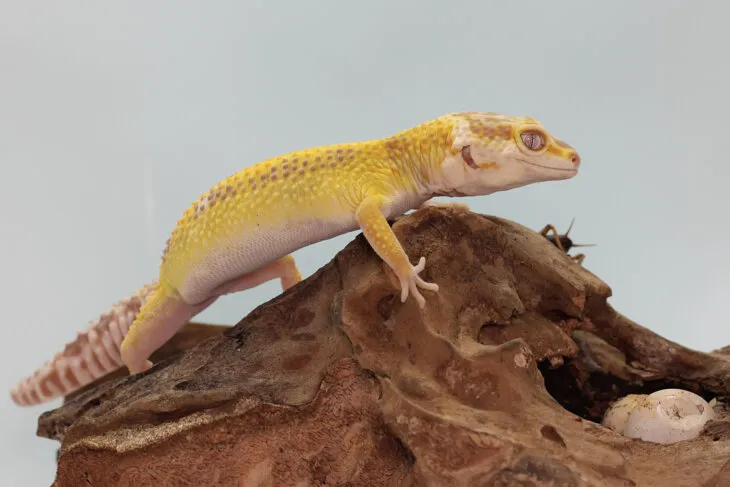
Where To Get Crickets For Your Leopard Gecko
Crickets are easily available in many high street pet shops and online. Here are some suppliers we love.
Josh’s Frogs crickets are guaranteed to arrive alive, no matter the weather! They also offer a range of cricket-care accessories to help you keep your crickets alive for longer.
The crickets are very affordable, and come in a wide range of sizes.
Josh’s Frogs are based in Owosso, Michigan. They ship orders that are placed by 12.00 pm EST the same day.
Fluker’s Farm is a very well-known breeder and supplier of crickets and other feeder insects. They sell crickets in 6 different sizes, and offer subscription services so that you never run out.
Fluker’s Farm also produces a range of cricket feed and care accessories. They are based in Los Angeles and guarantee live delivery during spring, summer and fall.
How To Store Crickets For Your Leopard Gecko
Crickets can be kept alive for up to 10 weeks of age, if you provide good care. This is ideal if you have an adult Leopard Gecko who can eat fully-grown crickets.
Crickets need to be provided with an enclosure that is 1 gallon in volume per 100 crickets. If you can provide a bigger
You don’t need to spend much on a cricket
We recommend getting this box here!
To provide shelter for your crickets, place in a material such as cardboard egg cartons. Tear them into pieces to create hiding places and substrate. Your crickets may be delivered with this type of substrate.
Provide
This will keep them alive and also gut load them effectively, which is beneficial to your Leopard Gecko.
To provide water, don’t put a dish in the enclosure. Instead, provide bug gel such as Fluker’s Cricket Quencher.
It is fortified with calcium which will help improve their calcium to phosphorus ratio. Also, it is safe as the crickets can’t drown in it.
Every few weeks, be sure to thoroughly clean and dry your cricket habitat. Taking care of your crickets will save you money in the long-run and also ensure that the crickets provide the best nutrition for your Leopard Gecko.
Why You Can’t Feed Only Crickets To Your Leopard Gecko
Your Leopard Gecko needs a varied diet (take a look at our diet guide here) of different insects that fully meet his changing nutritional requirements over the course of his life.
While crickets are a good staple feeder, they should be alternated with other feeder insects, or supplemented with other insects to create a healthy diet.
The primary reasons why Leopard Geckos cannot eat solely crickets is because they have a poor calcium to phosphorus ratio, and they are very low in fat.
The ideal dietary calcium to phosphorus ratio for Leopard Geckos is 1:1 to 2:1. Crickets only provide a Ca:P ratio of 1:9. What this means is that over time, your Leopard Gecko will not be getting enough calcium.
This is because the excessive phosphorus will be binding the calcium into a form that is not available for use by the body.
As a result, your Leopard Gecko’s body will have to draw the calcium it needs from its skeleton.
So, your Leopard Gecko will become weak, lethargic, deformed, and will eventually die with medical help. This is called metabolic bone disorder, and it is very common among pet reptiles.
The low fat content in crickets can also cause health problems. Young, sick, and gravid Leopard Geckos are all at greater risk of these two issues than healthy adult geckos.
Find out more about why Leopard Geckos Can’t Eat Only Crickets in our article here.
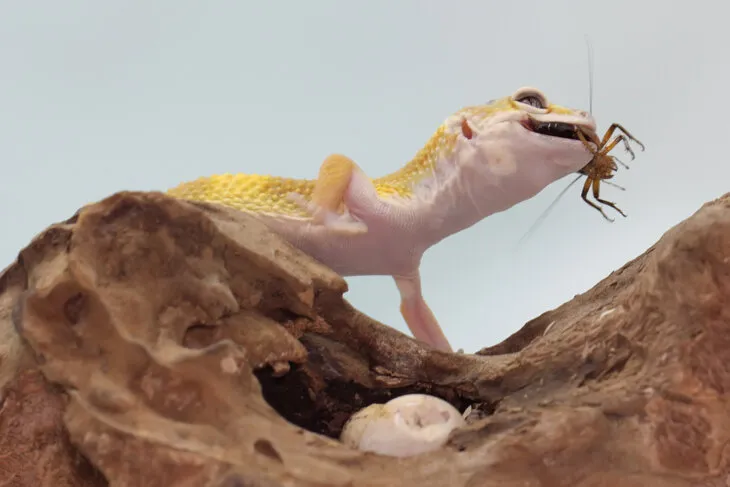
How Many Crickets To Feed To Your Leopard Gecko
How many crickets you need to feed your Leopard Gecko depends on many factors. For example, the size, life stage, and health of your Leopard Gecko.
Leopard Geckos who are growing, healing, or producing eggs need more calories, protein and calcium than standard Leopard Geckos.
However, a general guide is that a Leopard Gecko would need between 5-8 crickets per meal, if he wasn’t eating anything less for that meal. Here’s an example of a more varied diet for an adult Leopard Gecko.
| Monday | 5-6 large crickets | 2-3 medium-fat larval feeder |
| Wednesday | 5-6 large crickets (dusted) | 2 wax worms (every other week) |
| Saturday | 5-6 large crickets (dusted) | 2-3 medium-fat larval feeder |
Also, portion size is controlled by selecting appropriately-sized crickets for your Leopard Gecko. Here’s a guide to the approximate sizes of cricket that your Leopard Gecko needs by age.
| Age of Leopard Gecko | Size of cricket | Age of cricket | Category |
| Baby0 – 4 months | Pinhead to ¼ inch | Newborn to 2 weeks | Small |
| Juvenile4 – 10 months | ⅜ to ⅝ inch | 2.5 to 3.5 weeks | Medium |
| Adult10+ months | ¾ to 1 inch | 4 to 4.5 weeks | Large |
Remember, though, that all Leopard Geckos are a little different, and may not follow this guide perfectly. Select a cricket for your gecko that is narrower than the space between their eyes.
Also, observe your Leopard Gecko eating to ensure that they are not struggling to swallow a cricket that is too big.
You can find out more about how many crickets you should feed your Leopard Gecko by reading our step by step guide.
How To Feed Crickets To Your Leopard Gecko
Due to the very poor calcium to phosphorus ratio of crickets it is essential to prepare them by gut loading them for 48 hours before giving them to your Leopard Gecko. You can do this by providing commercial cricket
It is also very important to dust the crickets with calcium and vitamin powder. To do this simply place the crickets into a sandwich bag, along with some powder.
Gently shake it up to coat the crickets. This must be done immediately before offering the crickets to your Leopard Gecko.
For young, sick, and gravid Leopard Geckos, it is important to dust their crickets every time. They are more susceptible to metabolic bone disease and require more calcium and vitamin D.
However, for healthy adult Leopard Geckos, it is possible to cause different health issues by over-supplementing. Therefore, it is best to supplement only one or two meals per week with calcium powder for adult Leopard Geckos.
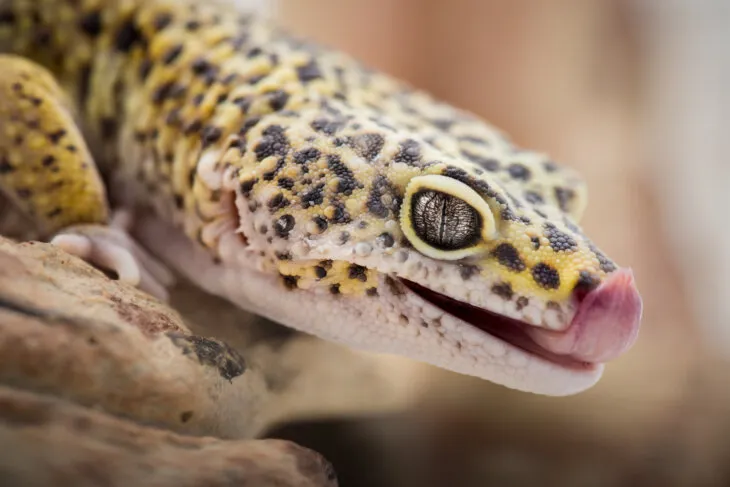
When giving the crickets to your Leopard Gecko, it is best not to throw them in the
Enjoy watching your Leopard Gecko hunting! This is also a great opportunity to observe how easily he can swallow the crickets, and judge if the size was right.
To help your Leopard Gecko avoid swallowing substrate, deliver the cricket on a smooth surface such as rock, if possible.
Swallowing substrate is dangerous as too much can cause an impaction. You can find out more about how to feed a Leopard Gecko crickets in our in-depth article.
Why You Can’t Leave Crickets In Your Leopard Gecko’s Tank
It is never a good idea to leave live insects in your Leopard Gecko’s
Even a tiny injury like this can become infected and pose a threat to your pet.
Also, the cricket could lay eggs, become sick, or die inside the
You can learn more about why we don’t recommend leaving crickets in your Leopard Gecko’s tank in our discussion article (here) on the potential risks and how to avoid them.
Why You Can’t Feed Dead Crickets To Your Leopard Gecko
It is possible to feed dead crickets to your Leopard Gecko, if they are a product such as freeze-dried crickets. These crickets have been killed, processed, and preserved in such a way as to render them safe for your Leopard Gecko.
However, it is not advisable to allow your Leopard Gecko to eat any sick, injured, or dead cricket. If you see a dead cricket you should throw it away.
By feeding unhealthy or dead crickets to your Leopard Gecko, you could introduce infection or parasites to your pet. This is because you cannot be sure what the cricket died of, or what microbes have set in since their death.
Furthermore, most Leopard Geckos only hunt and eat live
Note: We also recommend feeding brown crickets instead of black crickets. Learn more on that here.
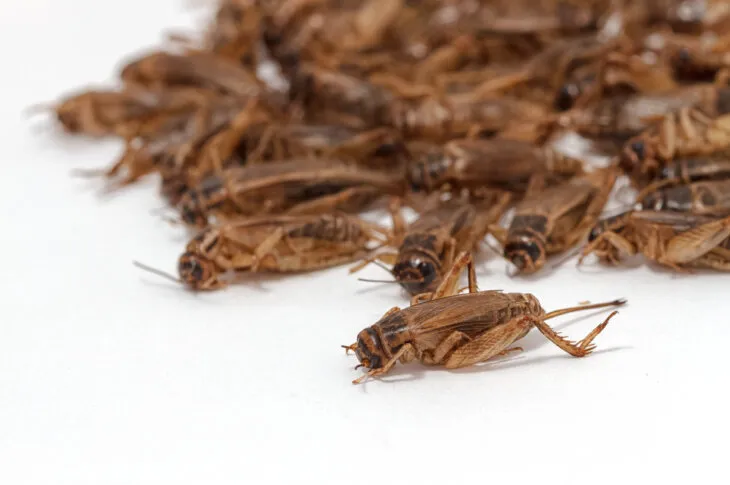
Troubleshoot Why Your Leopard Gecko Won’t Eat Crickets
Sometimes, Leopard Geckos stop eating. This can be very concerning, especially if it continues for a few weeks. The first thing to check is that your Leopard Gecko is not suffering from an impaction.
An impaction occurs when a bolus of
Gently massage your Leopard Gecko’s belly and check for lumps. You can also give your Leopard Gecko a shallow, lukewarm bath in this instance to help loosen any small impaction.
If your Leopard Gecko is toileting well and not showing any signs of impaction, there are many other reasons why he could have stopped eating.
If your leopard is overweight, this could be an early symptom of fatty liver disease. If your Leopard Gecko is overweight and stops eating, take them to the vet immediately.
If your Leopard Gecko is a female and preparing to lay eggs, she may become a very fussy eater and turn down
Offer her a variety of foods, and be ready to feed when she decides she wants to.
Otherwise, it could be a case of trying to make crickets more enticing to your Leopard Gecko. If you have been coating them thickly with calcium powder, try using a little less.
Overcoating can make crickets unpalatable to crickets.
Also, you could try to hand feed or tong feed a cricket or two, to stimulate your Leopard Gecko’s appetite. Once they have started eating, they will often continue by themselves.
You can discover more reasons why your Leopard Gecko is not eating crickets and ways to solve the problem by checking out our guide!
- Enchi Ball Python: A Unique and Stunning Morph of Python regius - March 27, 2025
- Emerald Tree Monitor: The Enigmatic Green Guardian of the Rainforest - March 26, 2025
- The Egyptian Cobra (Naja haje): A Fascinating Serpent - March 25, 2025

